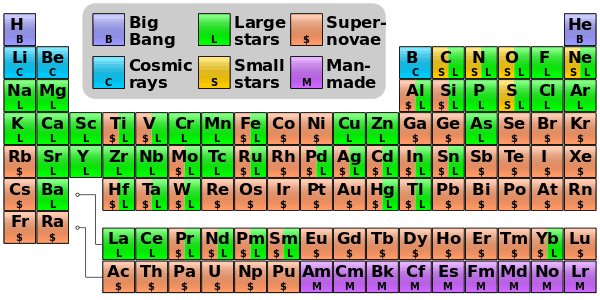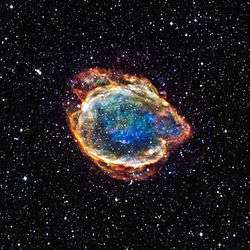r-process
The r-process is a nucleosynthesis process that occurs in core-collapse supernovae (see also supernova nucleosynthesis) and is responsible for the creation of approximately half of the neutron-rich atomic nuclei heavier than iron. The process entails a succession of rapid neutron captures (hence the name r-process) by heavy seed nuclei, typically 56Fe or other more neutron-rich heavy isotopes.
The other predominant mechanism for the production of heavy elements in the universe (and in the Solar System) is the s-process, which is nucleosynthesis by means of slow captures of neutrons, primarily occurring in AGB stars. The s-process is secondary, meaning that it requires preexisting heavy isotopes as seed nuclei to be converted into other heavy nuclei. Taken together, these two processes account for a majority of galactic chemical evolution of elements heavier than iron.
The r-process occurs to a slight extent in thermonuclear weapon explosions, and was responsible for the historical discovery of the elements einsteinium (element 99) and fermium (element 100).
History
The need for some kind of rapid capture of neutrons was seen from the relative abundances of isotopes of heavy elements given in a newly published table of abundances by Hans Suess and Harold Urey in 1956. Radioactive isotopes must capture another neutron faster than they can undergo beta decay in order to create abundance peaks at germanium, xenon, and platinum. According to the nuclear shell model, radioactive nuclei that would decay into isotopes of these elements have closed neutron shells near the neutron drip line, where more neutrons cannot be added. Those abundance peaks created by rapid neutron capture implied that other nuclei could be accounted for by such a process. That process of rapid neutron capture in neutron-rich isotopes is called the r-process. A table apportioning the heavy isotopes phenomenologically between s-process and r-process was published in the famous B2FH review paper in 1957,[1] which named that process and outlined the physics that guides it. B2FH also elaborated the theory of stellar nucleosynthesis and set substantial frame-work for contemporary nuclear astrophysics.
The r-process described by the B2FH paper was first computed time-dependently at Caltech by Phillip Seeger, William A. Fowler and Donald D. Clayton,[2] who achieved the first successful characterization of the r-process abundances and showed its evolution in time. They were also able using theoretical production calculations to construct more quantitative apportionment between s-process and r-process of the abundance table of heavy isotopes, thereby establishing a more reliable abundance curve for the r-process isotopes than B2FH had been able to define. Today, the r-process abundances are determined using their technique of subtracting the more reliable s-process isotopic abundances from the total isotopic abundances and attributing the remainder to the r-process nucleosynthesis. That r-process abundance curve (vs. atomic weight) gratifyingly resembles computations of abundances synthesized by the physical process.
Most neutron-rich isotopes of elements heavier than nickel are produced, either exclusively or in part, by the beta decay of very radioactive matter synthesized during the r-process by rapid absorption, one after another, of free neutrons created during the explosions. The creation of free neutrons by electron capture during the rapid collapse to high density of the supernova core along with assembly of some neutron-rich seed nuclei makes the r-process a primary process; namely, one that can occur even in a star of pure H and He, in contrast to the B2FH designation as a secondary process building on preexisting iron.
Observational evidence of the r-process enrichment of stars, as applied to the abundance evolution of the galaxy of stars, was laid out by Truran in 1981.[3] He and many subsequent astronomers showed that the pattern of heavy-element abundances in the earliest metal-poor stars matched that of the shape of the solar r-process curve, as if the s-process component were missing. This was consistent with the hypothesis that the s-process had not yet begun in these young stars, for it requires about 100 million years of galactic history to get started. These stars were born earlier than that, showing that the r-process emerges immediately from quickly-evolving massive stars that become supernovae. The primary nature of the r-process from observed abundance spectra in old stars born when the galactic metallicity was still small but that nonetheless contain their complement of r-process nuclei.

This scenario, though generally supported by supernova experts, has yet to achieve a totally satisfactory calculation of r-process abundances because the overall problem is numerically formidable; but existing results are very supportive.
The r-process is responsible for our natural cohort of radioactive elements, such as uranium and thorium, as well as the most neutron-rich isotopes of each heavy element.
Nuclear physics
Immediately after the severe compression of electrons in a core-collapse supernova, beta-minus decay is blocked. This is because the high electron density fills all available free electron states up to a Fermi energy which is greater than the energy of nuclear beta decay. But nuclear capture of those free electrons still occurs, and causes increasing neutronization of matter. There results an extremely high density of free neutrons which cannot decay, and as a result a large neutron flux (on the order of 1022 neutrons per cm2 per second ) and high temperatures. As this re-expands and cools, neutron capture by still-existing heavy nuclei occurs much faster than beta-minus decay. As a consequence, the r-process runs up along the neutron drip line and highly-unstable neutron-rich nuclei are created.
Three processes which affect the process of climbing the neutron drip line are; a notable decrease in the neutron-capture cross section at nuclei with closed neutron shells, the inhibiting process of photodisintegration, and the degree of nuclear stability in the heavy-isotope region. This last phenomenon terminates the r-process when its heaviest nuclei become unstable to spontaneous fission, which is currently believed to be in the neutron-rich region of the table of nuclides when the total number of nucleons approaches 270. After the neutron flux decreases, these highly unstable radioactive nuclei undergo a rapid succession of beta decays until they reach more stable, neutron-rich nuclei.[4] So, while the s-process creates an abundance of stable nuclei having closed neutron shells, the r-process creates an abundance of nuclei about 10 amu below the s-process peaks as a result of the decay back towards stability.
Astrophysical sites
The most probable candidate sites for the r-process has long been suggested to be core-collapse supernovae (spectral Type Ib, Ic and II), which may provide the necessary physical conditions for the r-process. However, the abundance of r-process nuclei requires that either only a small fraction of supernovae eject r-process nuclei to the interstellar medium, or that each supernova ejects only a very small amount of r-process material. In addition, the ejected material must be relatively neutron-rich, a condition which has been difficult to achieve in models.[5] An alternative site proposed in 1974[6] was decompressing neutron star matter. It was proposed such matter is ejected from neutron stars merging with black holes in compact binaries. In 1989[7] (see also [8]) this scenario was extended to binary neutron star mergers (a binary star system of two neutron stars that collide). These sites may now be starting to be observationally confirmed.[9]
References
- ↑ E. M. Burbidge; G. R. Burbidge; W. A. Fowler & F. Hoyle (1957). "Synthesis of the Elements in Stars". Reviews of Modern Physics. 29 (4): 547. Bibcode:1957RvMP...29..547B. doi:10.1103/RevModPhys.29.547.
- ↑ Seeger, Philip A.; Fowler, William A.; Clayton, Donald D. (1965). "Nucleosynthesis of heavy elements by neutron capture". Astrophysical Journal Supplement. 11: 121–66. Bibcode:1965ApJS...11..121S. doi:10.1086/190111.
- ↑ Truran, J. W. (1981). "A new interpretation of the heavy-element abundances in metal-deficient stars". Astronomy and Astrophysics. 97 (2): 391–93. Bibcode:1981A&A....97..391T.
- ↑ Clayton, Donald D. (1968). Principles of Stellar Evolution and Nucleosynthesis. New York: Mc-Graw-Hill. pp. 577–91. ISBN 978-0226109534., provides a clear technical introduction to these features. More technical is the previously cited paper by Seeger et al.
- ↑ Thielemann, F. K.; et al. (April 2011). "What are the astrophysical sites for the r-process and the production of heavy elements?". Progress in Particle and Nuclear Astrophysics. 66: 346–353. Bibcode:2011PrPNP..66..346T. doi:10.1016/j.ppnp.2011.01.032.
- ↑ Lattimer, James M.; Schramm, David N. (1974). "Black Hole-Neutron Star Collisions". The Astrophysical Journal Letters. 192: L145–147. Bibcode:1974ApJ...192L.145L. doi:10.1086/181612.
- ↑ Eichler, David; Livio, Mario; Piran, Tsvi; Schramm, David N. (13 July 1989). "Nucleosynthesis, neutrino bursts and gamma-rays from coalescing neutron stars". Nature. 340: 126–128. Bibcode:1989Natur.340..126E. doi:10.1038/340126a0.
- ↑ Freiburghaus, C.; Rosswog, S.; Thielemann, F.-K (1999). "R-Process in Neutron Star Mergers". The Astrophysical Journal Letters. 525 (2): L121––L124. Bibcode:1999ApJ...525L.121F. doi:10.1086/312343.
- ↑ Tanvir, N.; et al. (2013). "A `kilonova' associated with the short-duration gamma-ray burst GRB 130603B". Nature. 500 (7464): 547. arXiv:1306.4971
 . Bibcode:2013Natur.500..547T. doi:10.1038/nature12505.
. Bibcode:2013Natur.500..547T. doi:10.1038/nature12505.
Nuclear Stability in the Terminal Parts of the R-Process Path by Reginald Boleu
Inaugural dissertation, Lund University.
http://libris.kb.se/bib/119840

